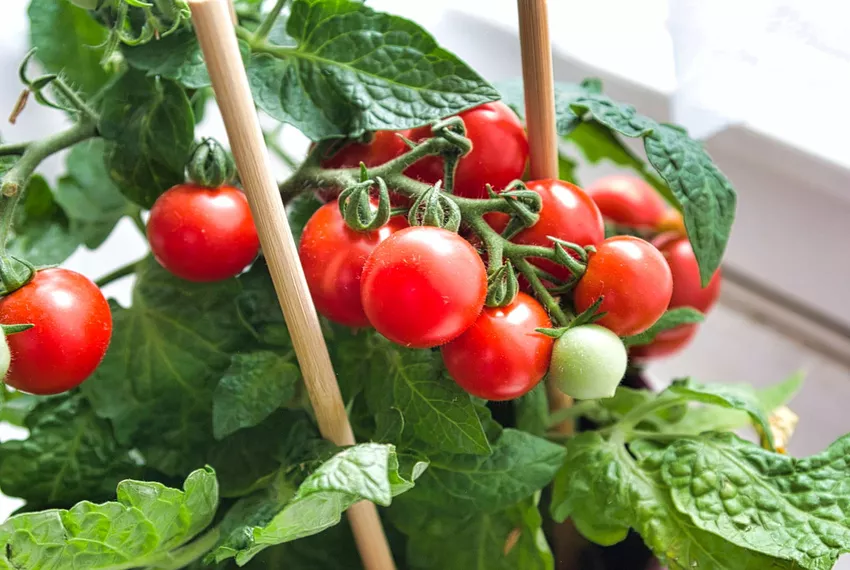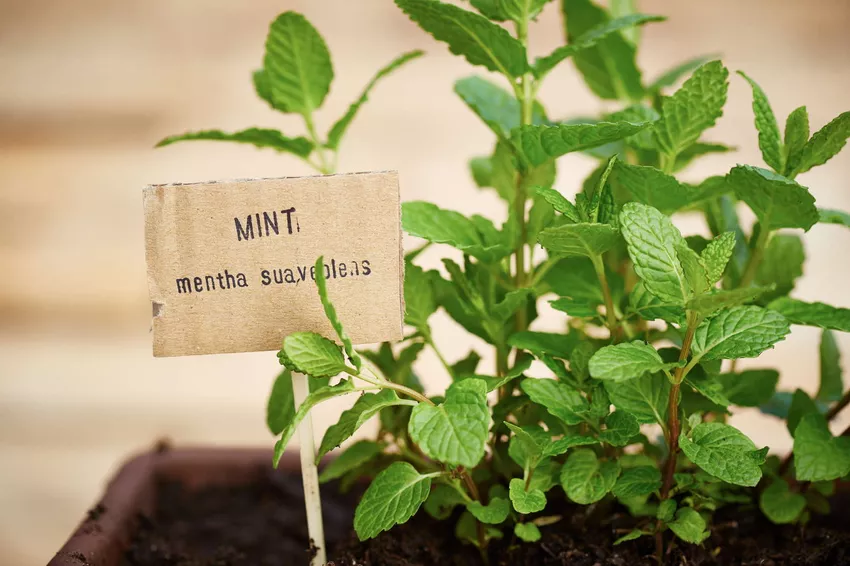No plants grow in winter? Are you kidding me? Are you serious when you say that! We will show you twelve types of herbs and vegetables that will thrive on your windowsill even in winter.

Winter is probably every gardener's least favorite season. Nothing grows, the garden lies fallow and one just waits longingly for the coming spring. But that doesn't have to be! We will show you twelve plants that can easily grow in your own four walls even in winter. Not only do you get fresh vegetables on your plate, you also don't suffer from withdrawal symptoms from not gardening.
12. Bush Beans
Admittedly, bush beans (Phaseolus vulgaris var. nanus) with a minimum pot size of 40 cm in diameter are not exactly suitable for the typical windowsill . However, green beans are ideal for growing in winter (and indoors). A big advantage is that, unlike other types of beans, they do not need a stake. Regular watering is a must, especially shortly after sowing the beans. A lot of light is also essential for the French bean - a place by a sunny window is therefore ideal for them.

11. Tomatoes
Small, round, red: Fresh tomatoes (Solanum lycopersicum) are a must in every kitchen. But since the plants are very sensitive to frost, winter is not for them. No problem, after all they can also thrive on our windowsill. With tomatoes, just like with their free-living summer colleagues, it is advisable to first germinate the seeds and transplant them later. There they need one thing above all: light! Since the light coming in at the kitchen window is often not enough in winter, it can be advisable to set up so-called plant lights that imitate sunlight. Incidentally, the most suitable for growing tomatoes are small and robust tomato varieties such as Pixie or Red Robin, which do not even need a stake.

10. Spinach
Spinach (Spinacia oleracea) has the sametwo advantages as a potted plant for the winter: on the one hand, it likes partial shade, so it can also thrive without artificial light (but the sun should shine for four hours a day, which is not a problem if you sit by the window). The second advantage is that you can harvest the plant again and again and it will grow back. Unfortunately, spinach also has a disadvantage: the green vegetable does not tolerate heat very well, which is why a place in the warm living room or above a heater is not really for it. But once you have found the right place, the spinach no longer needs much care - the spinach only needs regular watering and a little fertilizer from time to time to grow properly.

9. Paprika
Peppers (Capsicum) can also be grown in pots without any problems. However, since even the "small" varieties grow up to 80 cm high, the pepper is not necessarily suitable for the window sill - but very well for the apartment. The pepper feels at home in a warm, sheltered spot. In terms of care, the delicious plant has about the same requirements as tomatoes. The peppers also need a lot of light (and therefore possibly an extra plant lamp) and should be brought up on the windowsill and then repotted.

8. Kale
Kale (Brassica oleracea var. sabellica) is a typical winter vegetable. But although cabbage is very frost-resistant (and only really tasty after the first frost), winter can kill the stew vegetables. At the latest when there is extreme snowfall or hail, even the most robust plant can no longer withstand the cold - that's why we simply move the kale indoors. In a cooler room and with three to four hours of sunlight a day, kale also thrives here, so you can enjoy it all winter long.

7. Radish
With a planting time of just under a month, radishes (Raphanus sativus) are not only great for the window sill, they also ripen incredibly quickly. In addition, they do not require much space or care - an ideal plant for beginners. In a 10 cm high pot and a location with three to four hours of light, the radish will grow by itself. The young radishes do not need to be fertilized, they should only be watered about three timesthe week. Otherwise, the radish likes it a bit cooler. A place directly at the fireplace or the heating should therefore be avoided.

6. Arugula
Rucola (Eruca sativa), also known as salad rocket, is currently one of the most popular types of lettuce. No wonder, after all, the plant not only impresses with its nutty taste, but also contains many valuable ingredients. Rocket is also a hit on the window sill: Rocket thrives like cabbage and turnips in a sunny spot and is ready for the first cut after just four weeks. Only regular watering should not be forgotten. If the plants are exposed to drought and heat, they develop an extreme heat.
Tip: So that vegetables can also thrive on the windowsill, you should use a suitable substrate. Our Plantura organic tomato & vegetable soil creates optimal conditions for a rich harvest - even indoors.
5. Chard
Chard (Beta vulgaris subsp. vulgaris) as a pot plant is not only particularly easy to care for, but also with its colored stems and different varieties still particularly beautiful. A pot depth of 10 cm is ideal for the plant if you want to harvest small leaves (the larger the leaves should be, the larger the pot should be accordingly). Otherwise, the chard likes a cooler room with three to four hours of sunshine a day. Even frost does not usually bother the plant. A little fertilizer from time to time does not harm the plant either. A little tip: the chard leaves taste more tender if the plant has always had enough water. So make sure you have a good supply of water.

4. Spring Onion
Onions belong in every good dish and fresh spring onions (Allium fistulosum) should not be missing in any kitchen. Conveniently, you can also grow the delicious tubers in the kitchen. The ingenious thing: You don't even need seeds for this - you can easily grow new plants from the leftovers of purchased spring onions. Of course, as a root vegetable, the spring onion needs a sufficiently large (and above all deep) pot so that it can develop its bulbs properly. In a sunny location, the easy-care plants don't really need any special care apart from a little water from time to time.

3. Chives
We already knowchives (Allium schoenprasum) from the pot from the supermarket. But instead of throwing away the plant after use, you can continue to use it or grow your own little chive pot for the windowsill. So you always have a supply of the delicious herb. The chives are also not particularly care-intensive: Above all, they need a sunny location and regular watering, the plant should under no circumstances dry out. With a little fertilizer every four weeks, the chives are then perfectly cared for.

2. Oregano
Oregano (Origanum vulgare) is also one of the herbs we know from the windowsill. That is not surprising, after all, the kitchen herb is not only particularly tasty, but can also be perfectly grown in a pot. The oregano likes it warm and sunny best - a place by a south-facing window is ideal. Regular watering, when the soil of the plant feels dry, will help the oregano grow big and strong. If you buy the oregano in a pot from the supermarket, you should repot it in good time: the pots are often too small for the plant and thus prevent he althy development.

1. Mint
Mint (Mentha) is also one of the classic potted herbs. Many varieties of the green plant with the wonderfully fresh aroma are ideal for pots, including exotic species such as pineapple or strawberry mint. Fortunately, the mint does not need an exceptional amount of care for good growth: only regular watering and a sunny spot will help the plant to thrive. So you can enjoy a piece of summer (in the form of delicious mint) even in winter.

And if you don't just want to plant greenery on your window sill, but rather the whole apartment, then you will find the best indoor plants here.